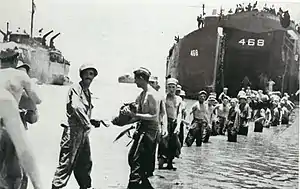 A working party landing stores from USS LST-468 to the beach. Note two unidentified LST's in background. | |
| History | |
|---|---|
| Name | LST-468 |
| Ordered | as a Type S3-M-K2 hull, MCE hull 988[1] |
| Builder | Kaiser Shipbuilding Company, Vancouver, Washington |
| Yard number | 172[1] |
| Laid down | 20 October 1942 |
| Launched | 24 November 1942 |
| Commissioned | 5 March 1943 |
| Decommissioned | 2 April 1946 |
| Stricken | 5 June 1946 |
| Identification |
|
| Honors and awards | |
| Fate | Sold for scrapping, 30 September 1947 |
| General characteristics [2] | |
| Class and type | LST-1-class tank landing ship |
| Displacement |
|
| Length | 328 ft (100 m) oa |
| Beam | 50 ft (15 m) |
| Draft |
|
| Installed power |
|
| Propulsion |
|
| Speed | 12 kn (22 km/h; 14 mph) |
| Range | 24,000 nmi (44,000 km; 28,000 mi) at 9 kn (17 km/h; 10 mph) while displacing 3,960 long tons (4,024 t) |
| Boats & landing craft carried | 2 or 6 x LCVPs |
| Capacity |
|
| Troops | 16 officers, 147 enlisted men |
| Complement | 13 officers, 104 enlisted men |
| Armament |
|
| Service record | |
| Part of: | LST Flotilla 7 |
| Operations: |
|
| Awards: | |
USS LST-468 was a United States Navy LST-1-class tank landing ship used in the Asiatic-Pacific Theater during World War II. As with many of her class, the ship was never named. Instead, she was referred to by her hull designation.
Construction
The ship was laid down on 20 October 1942, under Maritime Commission (MARCOM) contract, MC hull 988, by Kaiser Shipyards, Vancouver, Washington; launched 24 November 1942; and commissioned on 5 March 1943.[1]
Service history
During World War II, LST-468 was assigned to the Asiatic-Pacific theater. She took part in the Eastern New Guinea operations, the Lae occupation in September 1943, and the Saidor occupation in January and February 1944; the Bismarck Archipelago operations, the Cape Gloucester, New Britain landings in December 1943 and February 1944, and the Admiralty Islands landings in March 1944; Hollandia operation in April 1944; the Western New Guinea operations, the Biak Islands operation in May and June 1944, the Noemfoor Island operation in July 1944, the Cape Sansapor operation in August 1944, and the Morotai landing in September 1944; the Leyte operation in October and November 1944; the Lingayen Gulf landings in January 1945; the consolidation and capture of the Southern Philippines, the Mindanao Island landings in April 1945.[3]
Following the war, LST-468 returned to the United States and was decommissioned on 12 April 1946, and struck from the Navy list on 5 June, that same year. On 30 September 1947, the tank landing ship was sold to the Patapsco Scrap Corp., Baltimore, Maryland, and subsequently scrapped.[3]
Honors and awards
LST-468 earned seven battle stars for her World War II service.[3]
Notes
- Citations
Bibliography
Online resources
- "LST-468". Dictionary of American Naval Fighting Ships. Naval History and Heritage Command. Retrieved 13 April 2017.
 This article incorporates text from this source, which is in the public domain.
This article incorporates text from this source, which is in the public domain. - "Kaiser Vancouver, Vancouver WA". www.ShipbuildingHistory.com. 27 November 2010. Retrieved 13 April 2017.
- "USS LST-468". Navsource.org. 16 May 2014. Retrieved 13 April 2017.
External links
- Photo gallery of USS LST-468 at NavSource Naval History